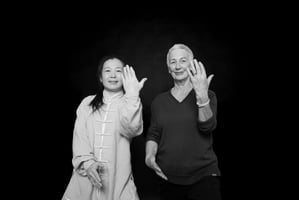Embark on a journey of self-discovery and rejuvenation at our "Flowing Vitality: Tai Chi & Qi Gong...
Chi and wairua: Navigating the Spiritual Realm
Rongoā and Tai Chi
In my recent rongoā class, we discussed the mysterious concepts of wairua and mauri. Wairua, akin to the English world soul or spiritual realm, and mauri, translated as the subtle energy or life force, weaving the fabric of existence. The idea that everything possesses mauri, this essence of life force, resonates deeply with me. It's reminiscent of the Chi/Qi/Ki (气) in Chinese philosophy – that invisible benevolent energy that binds all things together.
%20symbol.%20The%20h.jpg?width=1024&height=1024&name=DALL%C2%B7E%202024-02-14%2018.52.49%20-%20Create%20an%20image%20blending%20the%20serene%20beauty%20of%20a%20female%20hand%20holding%20a%20lotus%20flower%20with%20the%20profound%20symbolism%20of%20the%20tai%20chi%20(yin-yang)%20symbol.%20The%20h.jpg)
Mauri and Tai Chi
Reflecting on Mastern's insight, mauri originating from 'Te Kore.' "Te Kore" is a Māori term that refers to the state of potentiality or the realm of the unmanifested. It represents a state of emptiness or nothingness from which all things emerge and come into being. In Māori cosmology, Te Kore is often associated with the pre-creation phase, where the universe exists in a state of pure potentiality before it takes form. It speaks to the profound interconnectedness of all life, emerging from a primordial void.
In Taoism, "Wu Ji" is a concept closely related to Tai Chi. It refers to the state of emptiness or ultimate reality before the differentiation of Tai Chi ( Yin and Yang). Wu Ji represents the primordial state of pure potentiality, the void from which all things arise. In Tai Chi practice, there is often a focus on returning to Wu Ji, cultivating a sense of inner stillness and emptiness from which movement emerges. This state of Wu Ji is seen as the source of creativity, spontaneity, and infinite possibility.
t's intriguing to note that "Te Kore" in te reo Māori seems to correspond to "Wu Ji" in Chinese philosophy. Both concepts point to a state of primordial emptiness or pure potentiality from which all things emerge.
Similarly, "wairua" in Māori culture bears resemblance to what we call "shen" (神) in Chinese, often referred to as the inner higher self or spirit. In the practice of Tai Chi, as we relax and let go, we cultivate a deeper connection with our inner self, our shen. This invisible inner self guides us, bringing clarity and harmony to our movements.
When we align with our inner self, the mauri, or life force energy, naturally follows. This alignment leads to a holistic sense of well-being, strengthening our body, mind, and spirit. Through Tai Chi practice, we not only enhance our physical health but also nourish our spiritual essence, fostering a profound sense of balance and vitality.
Wairua has YinYang
Dr. Rose Pere's interpretation of wairua as 'two waters'.'Wai'means water, 'rua' means two Just like water can take life or give life, the spiritual realm holds dualities, reminding us of the delicate balance we must maintain for our well-being.
In Taichi, constantly flowing and balance of Yin and Yang, is the very core practice to achieve holistic wellbeing. The practice of Tai Chi is not just about physical movement but also about cultivating presence and harmony with the flow of chi. As we shift our weight from one leg to another, forward and backward, we also cultivate the healthy flow of chi/mauri in our body, and learn to navigate the ever-changing tides of existence with grace and resilience. It's a dance between embracing change and finding equilibrium amidst the changes – a journey of self-discovery and interconnectedness with the larger universe.

start tai chi practice today
As I continue to explore the depths of spirituality, I'm reminded to approach it with mindfulness and an open heart. It's a journey of unveiling mysteries, tapping into profound wisdom, and discovering the beauty of harmonizing mind, body, and spirit with the vastness of the spiritual realm.
Reflecting on these concepts is indeed fascinating, but true change comes from putting theory into practice, stepping onto the ground, and engaging in Tai Chi. Have you had the chance to practice today? I've just completed the 8-brocade treasure exercises and some standing meditation.
Have a good weekend!



